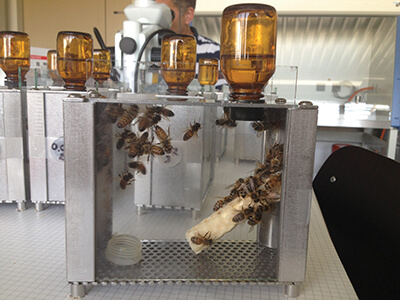
Do you have children who are picky eaters? Or, perhaps you’ve looked at the kid’s menu at a restaurant recently and thought, “Wow, that is some really bland food.” Or, perhaps in a weak moment, you’ve actually snuck a taste of some of the pasty pureed food from the baby aisle at the grocery store (don’t worry, no judging here at Notes from the Lab).
Regardless of how you’ve figured out that kid food is bland, you may not have known there are several potentially interesting reasons for why human babies prefer to eat bland food. And it turns out that those reasons may also be why honey bees feed their larvae bland food. This is the topic of our sixth “Notes from the Lab”, where we highlight “Nursing protects honey bee larvae from secondary metabolites of pollen”, written by Matteo Lucchetti and colleagues and published in the journal Proceedings of the Royal Society of London B [285:20172849 (2018)].
As spring kicks into high gear, hopefully you’ve been inspecting your brood frames and seeing lots of larvae. And along with the developing larvae, you’ve probably noticed that each one is swimming in a small pool of jelly. This is the stuff that makes the world go ‘round in the honey bee colony – “royal jelly” if a queen is being reared, “worker jelly” for soon-to-be workers, and “drone jelly” for developing drones.
The jelly is produced by nurse bees (via hypopharyngeal and mandibular secretions, of course) and gives the small larva a well-rounded diet of sugars, starches, proteins, vitamins and fat, so the larva can grow big and strong. And where do those all-important bee-building proteins, vitamins and fats come from? Before they’re secreted by nurse bees, they’re brought into the hive in the form of pollen.
Honey bees are unique in the bee world since they’re the only group of bees where adults consume the pollen and then transfer the nutrition to their offspring by nursing. Most of the other ~20,000 species of bees in the world – including solitary bees and other social bees, such as bumble bees – don’t nurse their babies. Instead, they directly feed them a mix of nectar and pollen.
Interesting… why do honey bees nurse their young if almost all other bees don’t? This is exactly the question that Lucchetti and colleagues wondered themselves, so they set out to find the answer.
The researchers first made the astute observation that most pollen contains toxins (often called secondary metabolites). These secondary metabolites are literally the spice of life, since they’re responsible for all the unique flavors on the spice rack in your kitchen – from thyme to rosemary to nutmeg to cinnamon. Secondary metabolites also keep you awake (caffeine) and give some people a buzz (nicotine). Blueweed, the plant of interest to the researchers in this study, is loaded with echimidine in its pollen, a pyrrolizidine alkaloid that’s related to caffeine and nicotine.
The researchers wanted to know if echimidine was toxic to bees. After determining how much echimidine was typically found in blueweed pollen, they fed this exact amount of echimidine to ….


